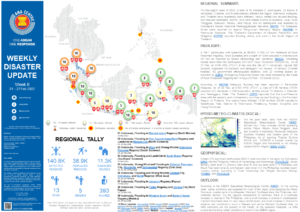
REGIONAL SUMMARY:
For the eighth week of 2022, a total of 40 disasters (1 earthquake, 22 floods, 6 landslides, 2 storms, and 9 wind-related) affected the region. Indonesia, Malaysia, and Thailand have reportedly been affected. Heavy rainfall has caused flooding, rain-induced landslides, storms, and wind-related events in Sumatra, Java, Nusa Tenggara, Sulawesi, Maluku, and Papua, and an earthquake was reported by Indonesia’s Badan Nasional Penanggulangan Bencana (BNPB). For Malaysia, floods were reported by Agensi Pengurusan Bencana Negara (NADMA) in Peninsular Malaysia. The Thailand’s Department of Disaster Prevention and Mitigation (DDPM) reported flooding, storm, and wind in the South Region of Thailand.
HIGHLIGHT:
A M6.1 earthquake with epicentre at 99.98E, 0.15N (17 km northeast of West Pasaman Regency, West Sumatra) and a depth of 10km occured in Indonesia on 25 Feb as reported by Badan Meteorologi dan Geofisika (BMKG). Modelling results show that this earthquake DID NOT have TSUNAMI POTENTIAL. As of 27 Feb, at 2145 HRS UTC+7, it has cost the life of 11 individuals, injured 388 persons, displaced 13K persons, and damaged 1.4K houses, 18 schools, 2 health facilities, 52 government offices/public facilities, and 22 worship places as reported by BNPB. Emergency Response Status has been instated by the Head of West Pasaman Regency for 14 days (25 Feb – 10 March 2022).
According to NADMA Malaysia, flooding has been reported in Peninsular Malaysia. As of 28 Feb, at 0700 HRS UTC+7, a total of 5.9K families (19.9K persons) still displaced in 224 evacuation centres across 15 districts in Kelantan and Terengganu State. The Thailand’s DDPM reported that the Low-Pressure Area with the easterly and northeasterly wind has caused flooding in the Southern Region of Thailand. The events have affected 12.2K families (60.6K people) in Narathiwat, Yala, Nakhon Si Thammarat, Phattalung, Pattani, Songkhla, and Trang Provinces.
HYDRO-METEO-CLIMATOLOGICAL:
For the past week, data from the ASEAN Specialised Meteorological Centre (ASMC) showed high 7-day average rainfall spreading across Papua, Maluku, Nusa Tenggara, Java and Sumatra in Indonesia; Peninsular Malaysia; Southern Thailand; and Eastern parts of the Philippines. As of reporting, Tropical Cyclone ANIKA and VERNON is located outside the ASEAN Region and forecasted to not directly impact ASEAN Region (BMKG,JTWC).
GEOPHYSICAL:
Sixteen (16) significant earthquakes (M?5.0) were recorded in the region by Indonesia’s BMKG and the Philippine Institute of Volcanology and Seismology (PHIVOLCS). Mount Semeru (alert level III), Dukono (alert level II), and Ibu (alert level II) in Indonesia, and Mount Taal (alert level 2), and Kanlaon (alert level 1) in the Philippines reported recent volcanic activity according to Pusat Vulkanologi dan Mitigasi Bencana Geologi (PVMBG) and PHIVOLCS.
OUTLOOK:
According to the ASEAN Specialised Meteorological Centre (ASMC), for the coming week, wetter conditions are expected for much of the region encompassing the Malay Peninsula, coastal parts of southeastern Mainland Southeast Asia, the Philippines, and northeast Borneo. For the regional assessment of extremes, there is a moderate increase in chance in The Philippines, and a small increase in chance in southeastern mainland Southeast Asia for very heavy rainfall event; and small increase in chance for extreme cold conditions to occur in Western and central Mainland Southeast Asia. La Niña conditions are still present in the Pacific. At the seasonal timescale, La Niña events tend to bring wetter conditions to much of the ASEAN region.
Sources:
ASEAN Disaster Monitoring & Response System (DMRS); ASEAN Specialised Meteorological Centre (ASMC); Joint Typhoon Warning Centre (JTWC)
Indonesia: BNPB, BMKG, PVMBG;
Malaysia: NADMA;
Philippines: PHIVOLCS;
Thailand: DDPM;
Various news agencies







